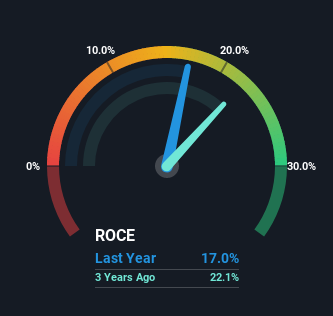- India
- /
- Aerospace & Defense
- /
- NSEI:BDL
The Returns On Capital At Bharat Dynamics (NSE:BDL) Don't Inspire Confidence

What trends should we look for it we want to identify stocks that can multiply in value over the long term? Ideally, a business will show two trends; firstly a growing return on capital employed (ROCE) and secondly, an increasing amount of capital employed. Basically this means that a company has profitable initiatives that it can continue to reinvest in, which is a trait of a compounding machine. Although, when we looked at Bharat Dynamics (NSE:BDL), it didn't seem to tick all of these boxes.
Return On Capital Employed (ROCE): What Is It?
For those who don't know, ROCE is a measure of a company's yearly pre-tax profit (its return), relative to the capital employed in the business. To calculate this metric for Bharat Dynamics, this is the formula:
Return on Capital Employed = Earnings Before Interest and Tax (EBIT) ÷ (Total Assets - Current Liabilities)
0.17 = ₹7.4b ÷ (₹68b - ₹25b) (Based on the trailing twelve months to September 2022).
Therefore, Bharat Dynamics has an ROCE of 17%. On its own, that's a standard return, however it's much better than the 12% generated by the Aerospace & Defense industry.
Check out our latest analysis for Bharat Dynamics

Historical performance is a great place to start when researching a stock so above you can see the gauge for Bharat Dynamics' ROCE against it's prior returns. If you want to delve into the historical earnings, revenue and cash flow of Bharat Dynamics, check out these free graphs here.
What Does the ROCE Trend For Bharat Dynamics Tell Us?
When we looked at the ROCE trend at Bharat Dynamics, we didn't gain much confidence. Over the last five years, returns on capital have decreased to 17% from 22% five years ago. Although, given both revenue and the amount of assets employed in the business have increased, it could suggest the company is investing in growth, and the extra capital has led to a short-term reduction in ROCE. And if the increased capital generates additional returns, the business, and thus shareholders, will benefit in the long run.
On a related note, Bharat Dynamics has decreased its current liabilities to 36% of total assets. So we could link some of this to the decrease in ROCE. What's more, this can reduce some aspects of risk to the business because now the company's suppliers or short-term creditors are funding less of its operations. Since the business is basically funding more of its operations with it's own money, you could argue this has made the business less efficient at generating ROCE.
The Key Takeaway
While returns have fallen for Bharat Dynamics in recent times, we're encouraged to see that sales are growing and that the business is reinvesting in its operations. And the stock has done incredibly well with a 225% return over the last three years, so long term investors are no doubt ecstatic with that result. So should these growth trends continue, we'd be optimistic on the stock going forward.
On a final note, we found 2 warning signs for Bharat Dynamics (1 is significant) you should be aware of.
If you want to search for solid companies with great earnings, check out this free list of companies with good balance sheets and impressive returns on equity.
Valuation is complex, but we're here to simplify it.
Discover if Bharat Dynamics might be undervalued or overvalued with our detailed analysis, featuring fair value estimates, potential risks, dividends, insider trades, and its financial condition.
Access Free AnalysisHave feedback on this article? Concerned about the content? Get in touch with us directly. Alternatively, email editorial-team (at) simplywallst.com.
This article by Simply Wall St is general in nature. We provide commentary based on historical data and analyst forecasts only using an unbiased methodology and our articles are not intended to be financial advice. It does not constitute a recommendation to buy or sell any stock, and does not take account of your objectives, or your financial situation. We aim to bring you long-term focused analysis driven by fundamental data. Note that our analysis may not factor in the latest price-sensitive company announcements or qualitative material. Simply Wall St has no position in any stocks mentioned.
About NSEI:BDL
Bharat Dynamics
Manufactures and sells guided missiles and allied defence equipment in India.
Exceptional growth potential with excellent balance sheet.
Market Insights
Community Narratives




